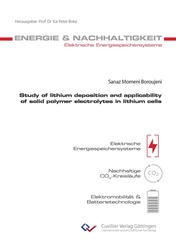| Departments | |
|---|---|
| Book Series (96) |
1378
|
| Nachhaltigkeit |
3
|
| Gesundheitswesen |
1
|
| Humanities |
2364
|
| Natural Sciences |
5406
|
| Engineering |
1793
|
| Engineering | 292 |
| Mechanical and process engineering | 862 |
| Electrical engineering | 686 |
| Mining and metallurgy | 30 |
| Architecture and civil engineering | 75 |
| Common |
98
|
|
Leitlinien Unfallchirurgie
5. Auflage bestellen |
|
Advanced Search
Study of lithium deposition and applicability of solid polymer electrolytes in lithium cells (Volume 10) (English shop)
Sanaz Momeni Boroujeni (Author)Preview
Extract, PDF (850 KB)
Table of Contents, PDF (120 KB)
Lithium (Li) deposition is a problem in Li batteries (LB) – both Li metal (LMB) and Li-ion (LIB) batteries – which limits their performance in terms of power and energy density. Two trends can be identified in the advancement of LBs concerning the problem of Li deposition: optimization of the existing system (the state-of-the-art LIBs) and further development of cell components such as electrolytes. This work addresses both approaches.
In the first part, this study investigates Li deposition in LMB and LIBs. A novel method to study the Li-based transport mechanisms in LIBs is introduced. Later the kinetic deviations between anode and cathode as a consequence of aging and the relation of these deviations to the occurrence of Li-plating are discussed.
In the second part, the applicability of PEO-based solid polymer electrolytes for LMBs to overcome the Li plating issue is investigated. The introduction of various interfacial interlayers at the cathode/electrolyte interphase was studied to improve the electrochemical stability of the cells. Cells with an in-situ electro-deposited interlayer showed the best cyclability.
| ISBN-13 (Hard Copy) | 9783736977099 |
| ISBN-13 (eBook) | 9783736967090 |
| Final Book Format | A5 |
| Language | English |
| Page Number | 174 |
| Lamination of Cover | matt |
| Edition | 1. |
| Book Series | Energie & Nachhaltigkeit |
| Volume | 10 |
| Publication Place | Göttingen |
| Place of Dissertation | Stuttgart |
| Publication Date | 2022-12-30 |
| General Categorization | Dissertation |
| Departments |
Electrical engineering
|
| Keywords | Lithium plating, Lithium (Li), Lithium deposition, Solid polymer electrolyte (SPE), Lithium battery (LB), Kinetic balancing, Kinetic properties of cell components, Li-ion battery (LIB), Li metal battery (LMB), state-of-the-art LIB, charge transport regions, charge transfer process, Li-based transport mechanisms, pseudo-two-dimensional (P2D) cell model, Solid Electrolyte Interphase (SEI), Anode’s aging mechanisms, Nernst-Einstein relation, Lithium metal anode, Graphite anode, NMC cathode, LiTFSI Salt, LiFSI Salt, Ether-based liquid electrolyte, Coulombic efficiency, Electrochemical stability of polymer electrolyte, Electrochemical stability window, electrochemical impedance spectroscopy (EIS), Cycling test, Polymer electrolyte, Ionic conductivity of polymer electrolyte, poly(ethylene oxide) (PEO), PEO-based SPE, intermediate coating layer, high voltage cathodes, poly(styrene)-b-poly(ethylene oxide) (PS-b-PEO), poly(styrene) (PS), poly(vinyl alcohol) (PVA), Lithium Aluminum Titanium Phosphate (LATP), cathode/electrolyte interphase, in-situ electro-deposition, Lithium-Ablagerung, Lithium (Li), Lithium-Beschichtung, Feststoff Polymerelektrolyt (SPE), Lithium-Batterie (LB), kinetisches Gleichgewicht, Kinetische Eigenschaften der Zellkomponenten, Li-Ionen-Batterie (LIB), Li-Metall Batterie (LMB), LIB auf dem Stand der Technik, Ladungstransportbereiche, Ladungstransportbereiche, Li-basierte Transportmechanismen, pseudo-zweidimensionales (P2D) Zellmodell, Feststoff-Elektrolyt-Grenzphase (SEI), Alterungsmechanismen der Anode, Nernst-Einstein-Beziehung, Lithium-Metall-Anode, Graphit-Anode, NMC-Kathode, LiTFSI-Salz, LiFSI-Salz, Flüssigelektrolyt auf Etherbasis, Coulomb-Effizienz (CE), Elektrochemische Stabilität von Polymerelektrolyten, Elektrochemisches Stabilitätsfenster (ESW), elektrochemische Impedanzspektroskopie (EIS), Zyklustest, Polymerelektrolyt, Ionenleitfähigkeit von Polymerelektrolyt, Poly(ethylenoxid) (PEO), SPE auf PEO-Basis, Zwischenschicht Beschichtung, Hochspannungskathoden, Poly(styrol)-b-Poly(ethylenoxid) (PS-b-PEO), Poly(styrol) (PS), Poly(vinylalkohol) (PVA), Lithium-Aluminium-Titan-Phosphat (LATP), Kathode/Elektrolyt-Interphase, In-situ-Elektroabscheidung |








